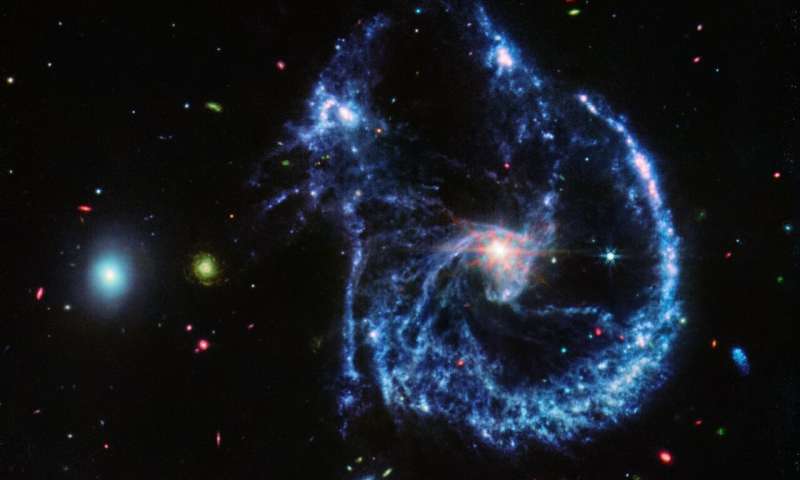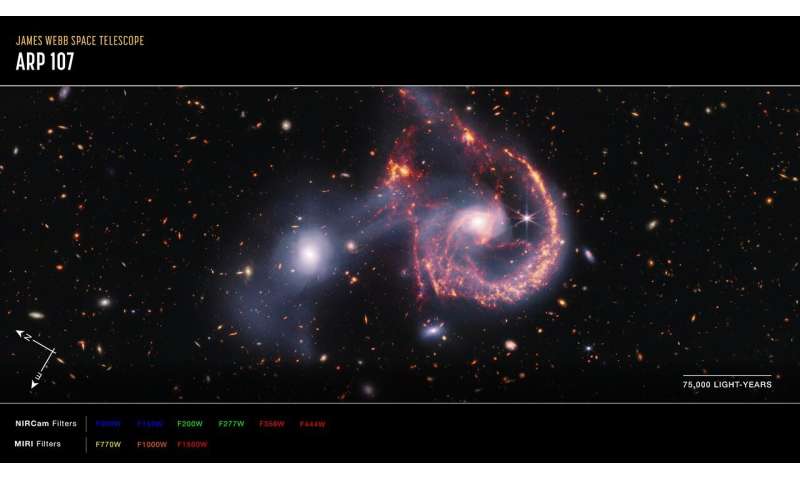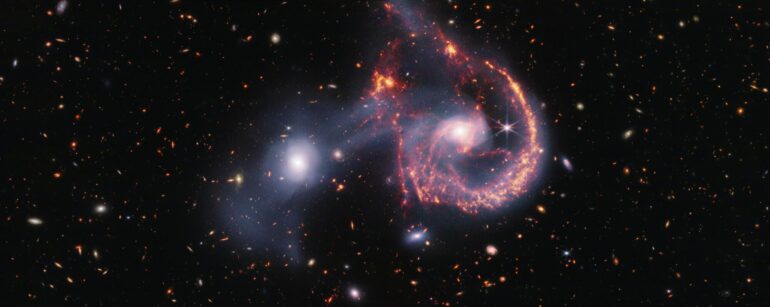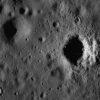An interaction between an elliptical galaxy and a spiral galaxy, collectively known as Arp 107, seems to have given the spiral a happier outlook thanks to the two bright “eyes” and the wide semicircular “smile.” The region has been observed before in infrared by NASA’s Spitzer Space Telescope in 2005. However, NASA’s James Webb Space Telescope displays it at much higher resolution. This image is a composite, combining observations from Webb’s MIRI (Mid-Infrared Instrument) and NIRCam (Near-Infrared Camera).
NIRCam highlights the stars within both galaxies and reveals the connection between them: a transparent, white bridge of stars and gas pulled from both galaxies during their passage. MIRI data, represented in orange-red, shows star-forming regions and dust that is composed of soot-like organic molecules known as polycyclic aromatic hydrocarbons. MIRI also provides a snapshot of the bright nucleus of the large spiral, home to a supermassive black hole.
The spiral galaxy is classified as a Seyfert galaxy, one of the two largest groups of active galaxies, along with galaxies that host quasars. Seyfert galaxies aren’t as luminous and distant as quasars, making them a more convenient way to study similar phenomena in lower energy light, like infrared.
This galaxy pair is similar to the Cartwheel Galaxy, one of the first interacting galaxies that Webb observed. Arp 107 may have turned out very similar in appearance to the Cartwheel, but since the smaller elliptical galaxy likely had an off-center collision instead of a direct hit, the spiral galaxy got away with only its spiral arms being disturbed.

This image of Arp 107, obtained by Webb’s MIRI (Mid-InfraRed Instrument), reveals the supermassive black hole that lies in the center of the large spiral galaxy to the right, as evidenced by the small, bright central ‘core’. This bright core, where the black hole is pulling much of the dust into lanes, also features Webb’s characteristic diffraction spikes, caused by the light that it emits interacting with the structure of the telescope itself. Perhaps the defining feature of the region, which MIRI reveals, are the millions of young stars that are forming, highlighted in blue. These stars are surrounded by dusty silicates and soot-like molecules known as polycyclic aromatic hydrocarbons. The small elliptical galaxy to the left, which has already completed much of its star formation, is composed of many of these organic molecules. © NASA, ESA, CSA, STScI

The north and east compass arrows show the orientation of the image on the sky. Note that the relationship between north and east on the sky (as seen from below) is flipped relative to the direction arrows on a map of the ground (as seen from above). The scale bar is labeled in light-years, which is the distance that light travels in one Earth-year. (It takes 75,000 years for light to travel a distance equal to the length of the bar.) One light-year is equal to about 5.88 trillion miles or 9.46 trillion kilometers. The field of view shown in this image is approximately 450,000 light-years across. This image shows invisible near-infrared and mid-infrared wavelengths of light that have been translated into visible-light colors. The color key shows which NIRCam and MIRI filters were used when collecting the light. The color of each filter name is the visible light color used to represent the infrared light that passes through that filter. © NASA, ESA, CSA, STScI
The collision isn’t as bad as it sounds. Although there was star formation occurring before, collisions between galaxies can compress gas, improving the conditions needed for more stars to form. On the other hand, as Webb reveals, collisions also disperse a lot of gas, potentially depriving new stars of the material they need to form.
Webb has captured these galaxies in the process of merging, which will take hundreds of millions of years. As the two galaxies rebuild after the chaos of their collision, Arp 107 may lose its smile, but it will inevitably turn into something just as interesting for future astronomers to study.
Arp 107 is located 465 million light-years from Earth in the constellation Leo Minor.
Citation:
Webb Telescope provides another look into galactic collisions (2024, September 18)



